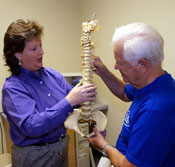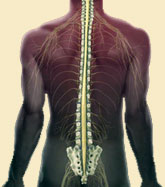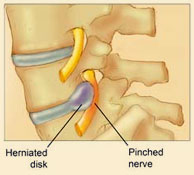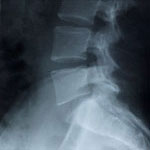About Chiropractic
Click a category below to jump to that section
•What is chiropractic?
•Frequently asked questions
•Levels of care
•What to expect on your first visit
What is chiropractic?

Chiropractic is the fastest growing natural health care profession in the world. Doctors of Chiropractic (DC's), specialize in finding, locating and removing a common condition known as Vertebral Subluxation.
A Vertebral Subluxation is a condition in which one or more of the twenty-four moveable bones of the spinal column is misaligned and interferes with the delicate nerves that exit between the spinal bones. This causes irritation to the nerve and impairs its ability to transmit or receive vital nerve messages from various parts of the body.
Chiropractic is based on the scientific fact that your body is a self regulating, self healing organism. These important functions are controlled by the brain, spinal cord, and all the nerves of the body.
Subluxations are commonly caused by stress from poor posture, poor sleeping habits, slips and falls, vehicular accidents, sports impacts, strenuous exercise, work injuries, childhood falls, medication and substance abuse, and even the birth process.
Chiropractic treatments, called spinal adjustments, are comfortable, safe, and highly effective. People of all ages, including infants and the elderly, can receive chiropractic care to get healthy and stay healthy.
Years of education, training, and experience enable your chiropractor to determine if chiropractic care can benefit you and/or members of your family. Chiropractors are highly educated, caring professionals who are sensitive to your natural health care needs.
Many people don't realize that chiropractic care has an excellent record of success in helping not only neck and back pain, but in conditions such as headaches, allergies, asthma, digestive disorders, and other organic health conditions, as well. Maintaining a healthy, well-aligned spine and normally functioning nervous system, is perhaps the most overlooked key to worldwide health.
Frequently asked questions
Answers to the questions patients ask the most about Chiropractic.
Q. How do you get Subluxations?
A. There are three basic causes of Vertebral Subluxation. Physical stresses on the spine and nervous system may include slips and falls, motor vehicle accidents, repetitive motion, and improper sleeping. Chemical stress includes smoking, alcohol abuse, not drinking enough water, improper diet, or the overuse of drugs or medications. Finally, emotional stress is a major cause of subluxation due to its effect on the hormonal and muscular systems of the body. Regardless of the cause, these subluxations need to be detected and removed.
Q. Can I tell if I have a subluxation?
A. Actually, you can have subluxations and not even know it. Like the early stages of tooth decay, subluxations can be present long before any symptoms emerge. Only chiropractors have the specific training to detect subluxation. Using special techniques like x-ray, surface electromyography, thermal scanning, and postural analysis, chiropractors can determine whether or not subluxations are present.
Q. What is an Adjustment?
 A. Adjustments are used by chiropractors to reposition the bones that are out of proper alignment, or subluxated. There are various techniques of adjusting the vertebrae. Depending on the patient's age, condition, and the doctor's training and experience, any of these techniques may be used. The purpose of the adjustments is to remove any interference to the nervous system, which improves spinal function and overall health. Adjustments are safe for all ages and are completely natural.
A. Adjustments are used by chiropractors to reposition the bones that are out of proper alignment, or subluxated. There are various techniques of adjusting the vertebrae. Depending on the patient's age, condition, and the doctor's training and experience, any of these techniques may be used. The purpose of the adjustments is to remove any interference to the nervous system, which improves spinal function and overall health. Adjustments are safe for all ages and are completely natural.
A chiropractic adjustment is the art of using a specific force in a precise direction, applied to a joint that is fixated, “locked up,” or not moving properly. This adds motion to the joint, helping the bone gradually return to a more normal position and motion. The purpose of this safe and natural procedure is improved spinal function, improved nervous system function, and improved health.
There are many ways to adjust the spine. Usually the doctor's hands, or a specifically designed instrument, delivers a brief and highly accurate thrust. Some adjusting methods are quick, whereas others require a slow and constant pressure.
Q. How Does Chiropractic Work?
 A. Chiropractic works by restoring your own inborn ability to be healthy. When under the proper control of your nervous system, all the cells, tissues, and organs of your body are designed to resist disease and ill health. The chiropractic approach to better health is to locate and help remove interferences to your natural state of being healthy.
A. Chiropractic works by restoring your own inborn ability to be healthy. When under the proper control of your nervous system, all the cells, tissues, and organs of your body are designed to resist disease and ill health. The chiropractic approach to better health is to locate and help remove interferences to your natural state of being healthy.
A common interference to the nervous system are the 24 moving bones of the spinal column. A loss of normal motion or position of these bones can irritate or impair the function of the nervous system. This can disrupt the transmission of controlling nerve impulses.
With improved spinal function, there is often improved nervous system function. Your chiropractic doctor can help remove interferences that may be impairing normal health.
Since the primary focus of your care is improved nervous system function, chiropractic can have a positive effect on many health conditions not normally thought of as “back or neck” problems. That’s why people can initially go to chiropractors for back pain and in the course of being seen for that their menstrual cramps, sinus, heartburn, and a multitude of other conditions go away.
Q. Are Chiropractic adjustments safe?
A. Yes. Chiropractic has an excellent safety record. A New Zealand government study found that adjustments are "remarkably safe." It is the result of chiropractic's conservative and natural approach that makes it so safe and helps millions of satisfied patients avoid harmful drugs or unnecessary surgery. Chiropractic care is safer than back surgery, muscle relaxers, and even common aspirin.
Q. What makes the sound during adjustments?
A. Actually, adjustments do not always produce a sound. However, some techniques do create a "popping" sound. This audible release is the result of gas shifting in the joint; similar to the noise created by "cracking" your knuckles. This sound is painless and causes no harm.
Q. Will I receive any medication for my pain?
A. Because chiropractors rely on the natural recuperative powers of the body, medication is not commonly used with chiropractic care. Typically, chiropractors use ice or moist heat to help control pain or muscle spasm. When properly applied, these methods can have an analgesic affect without the unwanted side effects of many medications. Chiropractors and medical doctors now enjoy strong working relationships. In severe cases, referrals may be made to other health care professionals if services outside of the scope of chiropractic are needed.
Q. Why do chiropractors take X-rays?
 A. In order to properly diagnose a patient's condition, x-rays are commonly taken. These x-rays are used to check vertebral alignment, disc degeneration, proper curvature, scoliosis, and other serious pathology. Many chiropractors use x-rays to document a patient's progress as well. With the advancement of high-speed film and limited exposure, the amount of radiation used is far outweighed by the useful information gained by actually seeing the patient's spine.
A. In order to properly diagnose a patient's condition, x-rays are commonly taken. These x-rays are used to check vertebral alignment, disc degeneration, proper curvature, scoliosis, and other serious pathology. Many chiropractors use x-rays to document a patient's progress as well. With the advancement of high-speed film and limited exposure, the amount of radiation used is far outweighed by the useful information gained by actually seeing the patient's spine.
Q. Is chiropractic care addictive?
A. Chiropractic is no more addictive than exercise, proper diet, or brushing your teeth. Chiropractors recommend getting your spine checked for subluxations periodically throughout your lifetime, because it is healthy for you to do so. Patients under long-term chiropractic care report an overall sense of health and well-being, far beyond diet and exercise alone. Most people initially come to chiropractors in pain and then choose to continue when they see how much better they feel and the better quality of life they enjoy.
Q. Can patients with arthritis receive chiropractic care?
A. Patients who suffer from the various forms of arthritis may get significant results from chiropractic. Depending on the patient, results may vary; however, by keeping the spinal joints moving freely, the stiffness and pain associated with arthritis can be minimized. If your doctor deems necessary, a referral to another health care provider may be suggested. Additionally, studies show that those who enjoy chiropractic from a younger age reduce their risk of osteoarthritis later in life.
Q. Can a person with previous back surgery see a chiropractor?
A.Unfortunately, research shows that up to one-half of those who have spinal surgery report a relapse of their original symptoms within months or years. This common occurrence is known as "Failed Back Surgery Syndrome," and usually results in the necessity of additional procedures. Chiropractic care may prevent repetitive surgeries, or better yet, if used initially, may help avoid surgery in the first place.
Q. Why do newborns get adjustments?
A. Even today's "natural" childbirth methods can cause spinal trauma. Studies suggest that infantile colic, poor appetite, ear infections, or erratic sleeping habits can be signs of spinal distress. Pediatric adjustments are gentle, safe, and offer a drugless alternative that many parents prefer. Pediatricians commonly refer to chiropractors for a natural approach for infant health problems.
Q. Do children need chiropractic care?
 A. Since significant spinal trauma can occur at birth, many parents have their newborns checked for Vertebral Subluxation. Naturally, chiropractic adjusting procedures are adapted for the child's spine. Many childhood health complaints can be traced back to nerve interference somewhere in the spine. Having the spine checked throughout childhood could prevent health problems that emerge in adulthood. Parents often prefer chiropractic care for their children because of its safe, non-invasive nature.
A. Since significant spinal trauma can occur at birth, many parents have their newborns checked for Vertebral Subluxation. Naturally, chiropractic adjusting procedures are adapted for the child's spine. Many childhood health complaints can be traced back to nerve interference somewhere in the spine. Having the spine checked throughout childhood could prevent health problems that emerge in adulthood. Parents often prefer chiropractic care for their children because of its safe, non-invasive nature.
Q. Is it OK to see a chiropractor if I'm pregnant?
A.Pregnant women frequently get amazing results from chiropractic. Chiropractors are trained in special techniques for adjusting pregnant women. Because of the inability to take medication for pain, the natural approaches of chiropractic are the logical choice for pregnant women. More and more, obstetricians are referring to chiropractors due to the effectiveness of spinal adjustments for pain relief. Also, techniques designed to naturally turn a Breech baby are safe and effective. Lastly, women under chiropractic care have a significantly faster delivery than those who are not.
Q. Do I have a Slipped Disk?
A.Discs are known as the "shock absorbers" of the spine and are made up of a fibrous outer ring with a jelly-like center. Commonly, a variety of disc problems throughout the spine may be referred to as a "slipped disc." A disc cannot actually slip because of the way it attaches into the bones above and below. Discs can tear, decay, bulge, or dehydrate, all of which can be serious problems. However, discs cannot slip.
While results can not be guaranteed, many patients have avoided needles, surgery or a dependency on pain pills by choosing chiropractic care for their disc-related health problems.
Q. Do I have a Pinched Nerve?
 A. A pinched nerve is a rare occurrence. Most likely, the pain you are experiencing is an adjacent spinal bone out of its proper alignment, causing irritation, slight compression, or stretching of a nerve. These misalignments, called Vertebral Subluxations, can distort the impulses being sent between the brain and the body. Any interference to these nerve signals can produce disorders in the tissues and organs. Numbness and tingling, like the feeling that your foot has gone to sleep, is a sign of a pinched nerve.
A. A pinched nerve is a rare occurrence. Most likely, the pain you are experiencing is an adjacent spinal bone out of its proper alignment, causing irritation, slight compression, or stretching of a nerve. These misalignments, called Vertebral Subluxations, can distort the impulses being sent between the brain and the body. Any interference to these nerve signals can produce disorders in the tissues and organs. Numbness and tingling, like the feeling that your foot has gone to sleep, is a sign of a pinched nerve.
Q. Do chiropractors keep you coming?
A. Most patients come to chiropractors, initially, in pain. Once they see how much better they feel they choose to continue with chiropractic care. No chiropractor can make someone go to them. People choose to continue care just as they continue to eat right, exercise, etc. to have their optimum level of health. {Dentists keep you coming and you do something for your teeth everyday. What have you done for your spine lately?}
Q. I’m not in pain, why do I need a chiropractor?
A. I bet you brushed your teeth this morning and they didn’t hurt. Chiropractic care will help you function at your optimum, reduce the risk of degeneration and arthritis, and allow your nervous system, telephone communication system for your body, function at its best.
Q. What’s the difference between medical doctors and chiropractors?
A. The biggest difference between chiropractors and medical doctors lies not in their level of education, but in their preferred method of caring for people. Medical doctors are trained in the use of medicines (chemicals that affect your internal biochemistry) and surgery. Consequently, if you have a chemical problem, such as diabetes, hypothyroidism, or an infection, medical doctors can be very helpful. However, if your problem is that your spine is mis-aligned or you have soft tissue damage causing pain, there is no chemical in existence that can fix it. You need a physical solution to correct a physical problem. That is where chiropractic really shines. Chiropractors provide physical solutions -- adjustments, exercises, stretches, muscle therapy -- to help the body heal from conditions that are physical in origin, such as back pain, muscle spasms, headaches, and poor posture. Another distinction is the fact that it is completely appropriate to receive chiropractic care even if you do not have symptoms. Unlike standard medical doctors, whom you visit when you have a symptom to be treated, chiropractors offer adjustments to improve spinal alignment and overall well-being before symptoms develop. The ideal health plan would include a medical doctor and a chiropractor. That way you get the best of both worlds. No health profession is the “be all, end all” to all your health care concerns.
Q. Who needs chiropractic care?
 A. Everyone needs chiropractic care, just like everyone needs a dentist. If you have a spine you can benefit from chiropractic care. You say, "Well, you're biased. I said, "Everyone needs chiropractic care"; I didn't say you had to come see me. If you want the best care, I suggest you come see me. Everyone needs a chiropractor, the only questions are which one should you go to;{We're all different.} and how often should you go.
A. Everyone needs chiropractic care, just like everyone needs a dentist. If you have a spine you can benefit from chiropractic care. You say, "Well, you're biased. I said, "Everyone needs chiropractic care"; I didn't say you had to come see me. If you want the best care, I suggest you come see me. Everyone needs a chiropractor, the only questions are which one should you go to;{We're all different.} and how often should you go.
Q. Can I adjust myself?
A. Since a chiropractic adjustment is a specific force, applied in a specific direction, to a specific spinal joint, it is virtually impossible to adjust yourself.
It is possible to turn or bend or twist in certain ways to create “popping” sounds. Unfortunately, this type of joint manipulation is usually counterproductive, often making an already unstable area of the spine even more unsteady. Adjusting the spine is for professionals. People sometimes “adjust themselves” because it gives them temporary relief but the long terms effect of this are not good because where there is a spinal segment that moves easily in and out of place, which is what you are popping, above or below that segment is one that is not moving and that is where the root of the problem lies. That is why chiropractors go to other chiropractors for their adjustments because you can’t move the joint that’s locked up.
Levels of care
Laying the foundation
Chiropractic care is like building a house – certain things have to happen in a particular order in order for everything to stand strong and work correctly. When building a house, if you tried to put up your walls before you had a solid foundation, your walls would be weak and eventually collapse. If you tried to put on your roof before the walls were ready, you would run into the same problem. The same is true for your body. Your body has to go through a particular plan of care in order to repair itself correctly and fully. There are three general phases of chiropractic care . . .
Phase 1: Relief Care
If you are in pain when you come into our office, the first objective is to help you feel better. The purpose of this phase is to simply make the pain go away. Depending on the severity of your problem, you may need care 3-4 adjustments per week.
Phase 2: Corrective/Restorative Care
During the corrective care phase, muscles and other tissues are allowed to heal more completely, thereby helping prevent injury. During this phase, we are working on stabilizing and strengthening the spine in order to correct the underlying problem that caused the pain.
Phase 3: Wellness Care
Once your body has fully healed, it is important to come in for periodic adjustments to avoid problems in the future. Usually, this only requires a quick visit to the chiropractor 1-4 times per month, based on your lifestyle and goals.
What to expect on your first visit
Patient Forms
Upon entering our office, our receptionist will greet you and welcome you as a member of our family. We will request that you fill out our new patient forms. The paperwork provides us with general information about yourself and your condition.
Consultation
 Next, you will have a consultation with Dr. Riley to discuss your health-related problems, concerns, as well as potential treatment options. Your first visit is designed for Dr. Riley to learn more about you, your condition, and your expectations to determine whether yours is a chiropractic case or not. If Dr. Riley believes she can help you, she will tell you. If not, she will tell you that too and refer you to someone who she believes can best serve you.
Next, you will have a consultation with Dr. Riley to discuss your health-related problems, concerns, as well as potential treatment options. Your first visit is designed for Dr. Riley to learn more about you, your condition, and your expectations to determine whether yours is a chiropractic case or not. If Dr. Riley believes she can help you, she will tell you. If not, she will tell you that too and refer you to someone who she believes can best serve you.
Examination
After your consultation, Dr. Riley will perform a complete chiropractic, neurologic, orthopedic, postural, and physical examination to diagnose your problem and determine if you are a chiropractic case.
X-Ray Studies
 Your specific condition may require us to take x-rays. Not to see is to guess, and we won’t guess about your health. X-rays help us rule out more serious conditions or assist us in developing the most effective treatment plan for you. Most people are amazed once they see their x-rays and can often immediately identify their misalignments and degeneration themselves.
Your specific condition may require us to take x-rays. Not to see is to guess, and we won’t guess about your health. X-rays help us rule out more serious conditions or assist us in developing the most effective treatment plan for you. Most people are amazed once they see their x-rays and can often immediately identify their misalignments and degeneration themselves.
Report of Findings
Once all the information and examinations have been performed, Dr. Riley will give you a report of findings to answer the 4 most popular questions:
1.What’s wrong?
2.Can you help me?
3.How long will it take to correct and get better?
4.How much is it going to cost?
After discussing with you your history and your goals, examining your spine and reviewing any x-rays or tests, Dr. Riley will discuss recommendations with you. If you have a condition that requires care with other providers, the doctor will tell you. If Dr. Riley believes we can help you, she will recommend treatment and a wellness program.
Treatment
Patients will generally be provided with their first treatment at the conclusion of the appointment. This may include spinal adjustments, physical therapy, and/or soft tissue therapies. Treatment is interactive with you, so you can express any concerns you have about the style of adjustment you will be most comfortable with.
Wellness Program Prior to leaving, patients will be instructed on a wellness program to be conducted at home. If you are in pain when you first come into our office, this may include ice or heat application instructions, avoidance of certain activities or positions, as well as home exercises and/or stretches. If you desire an overall wellness lifestyle, our wellness team will work with you to create good habits and routines that support your success. Every body is unique and different and therefore everyone requires a unique and customized wellness plan. The foundation of our overall wellness lifestyle is maintaining healthy posture and good spinal alignment, eating a healthy diet, taking supplements, keeping your weight under control and stress relief.
Prior to leaving, patients will be instructed on a wellness program to be conducted at home. If you are in pain when you first come into our office, this may include ice or heat application instructions, avoidance of certain activities or positions, as well as home exercises and/or stretches. If you desire an overall wellness lifestyle, our wellness team will work with you to create good habits and routines that support your success. Every body is unique and different and therefore everyone requires a unique and customized wellness plan. The foundation of our overall wellness lifestyle is maintaining healthy posture and good spinal alignment, eating a healthy diet, taking supplements, keeping your weight under control and stress relief.






